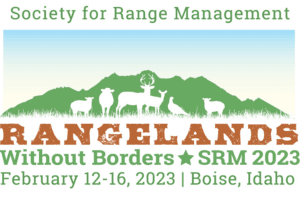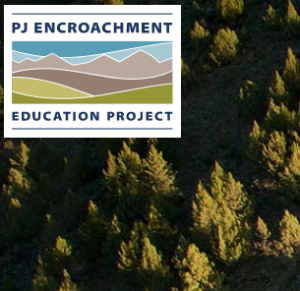Sagebrush
View article.
The magnitude of impact of tree encroachment on rangeland loss is similar to conversion to cropland, another well-known and primary mechanism of rangeland loss in the US Prioritizing conservation efforts to prevent tree encroachment can bolster ecosystem and economic sustainability, particularly among privately-owned lands threatened by land-use conversion.
Visit conference website.
This year’s annual conference will be in Boise, ID.
Visit the website.
Around the world, woodlands and forests are replacing native grasslands and shrublands which impacts wildlife and people. In the sagebrush biome of the American West, pinyon pine, juniper, and other native conifer trees are expanding into imperiled shrublands. Learn more about the implications of this woodland encroachment and what communities are doing to restore healthy and resilient shrublands.
View article.
Seeds were captured across the range of tested dispersal distances, up to a maximum distance of 26 m from seed-source plants, although dispersal to the furthest traps was variable. Seed dispersal was better explained by transect heterogeneity than by patch or site heterogeneity (transects were nested within patch within site). The number of seeds captured varied from a modelled mean of ~13 m -2 adjacent to patches of seed-producing plants, to nearly none at 10 m from patches, standardized over a 49-day period. Maximum seed-dispersal distances on average were estimated to be 16-m according to a novel modelling approach using a “latent” dispersal distance based on seed trapping heights.
Modeling fire spread in sagebrush steppe using FARSITE: Improving input data and simulation accuracy
View article.
Using RAP to inform pre-fire FBFM selection increased the accuracy of FARSITE simulations compared to parameterization with the standard LANDFIRE FBFM maps, in sagebrush steppe. Additionally, the crosswalk method appeared to have regional generalizability. Flanking and backfires were the primary source of disagreements between simulated and observed fire spread in FARSITE, which are sources of error that may require modeling of lateral heterogeneity in fuels and fire processes at finer scales than used here.
View report.
A spatial overlap analysis was performed and highlighted 45.8 million acres of shared priorities among existing conservation frameworks to help anchor and guide collaborative landscape-scale conservation of areas that still have no to low threats. This information is critical to provide context for decisions about the volume and nature of conservation actions and funding requirements.
View article.
We evaluated plant community succession following prescribed fire on Artemisia arbuscula var. arbuscula (low sagebrush) steppe in southeastern Oregon. Treatments were “prescribed burned” (burn; fall 2012) and “unburned” (control) low sagebrush a steppe, and the study design was a randomized complete block with 4 replicates per treatment. Herbaceous yield and vegetation canopy cover and density were compared between treatments (2012–2020). Fire practically eliminated low sagebrush and there was no recruitment of new plants in the first 8 years after burning. Herbaceous yield in the burn treatment was about double the control for most of the postfire period. Native perennial grasses and forbs constituted 94% to 96% and Bromus tectorum L. (cheatgrass) 0.2% to 2% of total herbaceous yield in the control. In the burn treatment, perennial grasses and forbs constituted 83% to 87%, native annual forbs 2% to 5%, and cheatgrass 3% to 9% of total herbaceous yield. Despite an increase in cheatgrass, the burned low sagebrush sites were dominated by herbaceous perennial grasses and forbs and exhibited high levels of resilience and resistance. After prescribed fire, for the study sites and comparable low sagebrush associations, weed control or seeding are not necessary to recover the native herbaceous community. However, the results in our study are for low-severity prescribed fire in intact low sagebrush plant communities. Higher-severity fire, as might occur with wildfire, and in low sagebrush communities having greater prefire invasive weed composition should not be assumed to develop similarly high levels of community resilience and resistance.
View article.
In 2006, we initiated fuel reduction treatments (prescribed fire, mowing, and herbicide applications [tebuthiuron and imazapic]) in six Artemisia tridentata ssp. wyomingensis communities. We evaluated long-term effects of these fuel treatments on: (1) magnitude and longevity of fuel reduction; (2) Greater sage-grouse habitat characteristics; and (3) ecological resilience and resistance to invasive annual grasses. Responses were analyzed using repeated-measures linear mixed models. Response variables included plant biomass, cover, density and height, distances between perennial plants, and exposed soil cover. Prescribed fire produced the greatest reduction in woody fuel over time. Mowing initially reduced woody biomass, which recovered by year 10. Tebuthiuron did not significantly reduce woody biomass compared to controls. All woody fuel treatments reduced sagebrush cover to below 15% (recommended minimum for Greater Sage-grouse habitat), but only prescribed fire reduced cover to below controls. Median mowed sagebrush height remained above the recommended 30 cm. Cheatgrass (Bromus tectorum) cover increased to above the recommended maximum of 10% across all treatments and controls. Ecological resilience to woody fuel treatments was lowest with fire and greatest with mowing. Low resilience over the 10 posttreatment years was identified by: (1) poor perennial plant recovery posttreatment with sustained reductions in cover and density of some perennial plant species; (2) sustained reductions in lichen and moss cover; and (3) increases in cheatgrass cover. Although 10 years is insufficient to conclusively describe final ecological responses to fuel treatments, mowing woody fuels has the greatest potential to reduce woody fuel, minimize shrub mortality and soil disturbance, maintain lichens and mosses, and minimize long-term negative impacts on greater sage-grouse habitat. However, maintaining ecological resilience and resistance to invasion may be threatened by increases in cheatgrass cover, which are occurring regionally.
View report.
This “Sagebrush Conservation Strategy—Challenges to Sagebrush Conservation,” is an overview and assessment of the challenges facing land managers and landowners in conserving sagebrush ecosystems. This strategy is intended to provide guidance so that the unparalleled collaborative efforts to conserve the iconic greater sage-grouse (Centrocercus urophasianus) by State and Federal agencies, Tribes, academia, nongovernmental organizations, and stakeholders can be expanded to the entire sagebrush biome to benefit the people and wildlife that depend on this ecosystem. This report is organized into 3 parts.
Part I. Importance of the Sagebrush Biome to People and Wildlife; Part II. Change Agents in the Sagebrush Biome—Extent, Impacts, and Effort to Address Them; and Part III. Current Conservation Paradigm and Other Conservation Needs for Sagebrush
View article.
Invasive annual grasses, wildfire, and climate change are changing ecosystem processes in the sagebrush biome at a pace and scale requiring an assessment of where processes can be saved, where they can be regained, and where they are lost. Confronting these threats is the primary focus of restoration and management efforts, guiding policy creation, project prioritization, and action on the ground. The new Defend the Core framework helps land managers, landowners, and policy makers to use the tools or management actions most likely to improve conditions.





